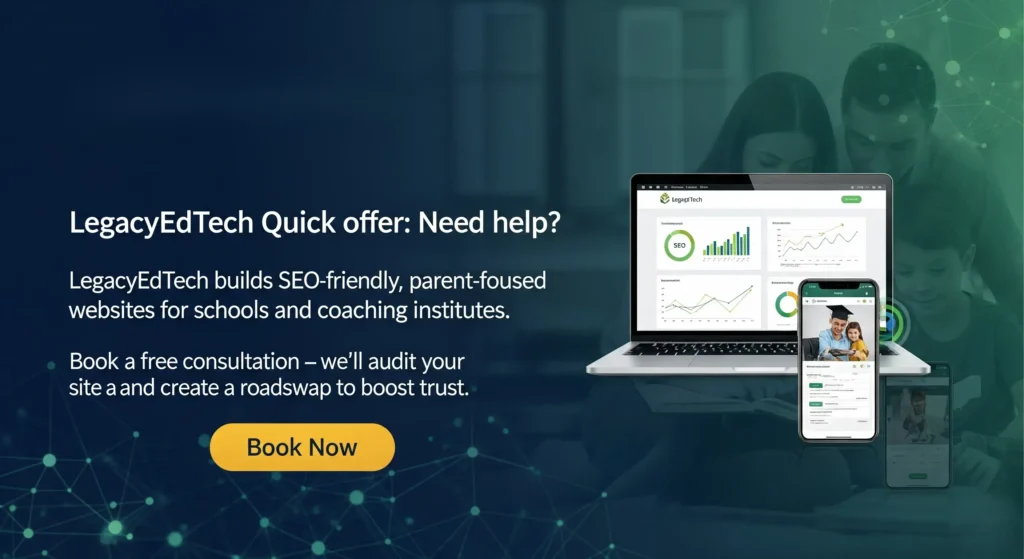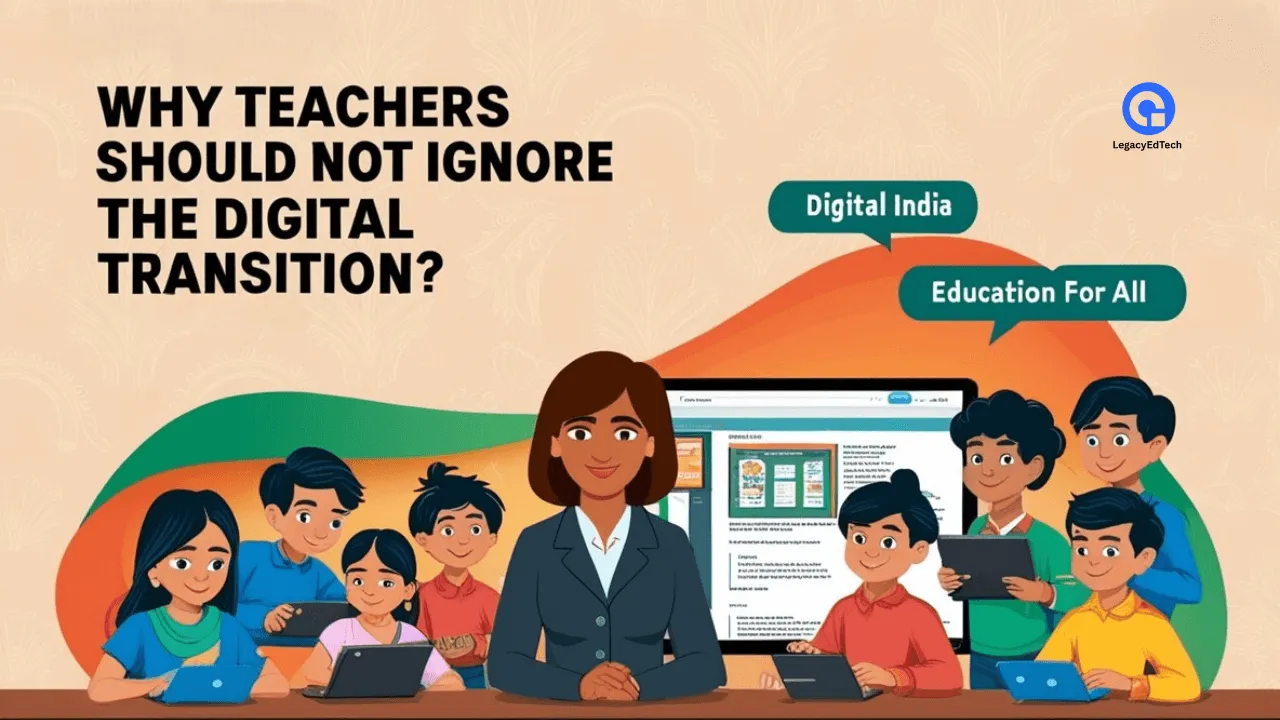Table of Contents
- Introduction
- Why School Owners Can No Longer Ignore Digital Transformation in Schools
- Cost of Ignoring Digital Transformation in Schools
- Real-World Results: EdTech Wins and Learning Gains
- Core Areas to Transform: Curriculum, Operations, and Culture
- Step-by-Step Roadmap for Digital Transformation in Schools
- Digital Transformation in Schools: Technology Checklist
- ROI, Cost Examples and Vendor Checklist
- Common Barriers and How to Overcome Them
- Case Study Snapshot: Small City School Pilot
- Policy and Compliance Pointers
- Quick Wins That Deliver Fast ROI
- How to Measure Success of Digital Transformation in Schools
- FAQs
- Conclusion
Introduction
Why are so many school owners still on the fence? The costs of standing still are rising fast. Parents demand modern learning. Teachers need tools. Operations groan under legacy processes. This blog explains why digital transformation in schools is no longer optional. It shows how EdTech adoption in schools can fix measurable pain points—fewer administration hours, better student engagement, and faster remedial action. You’ll get a clear roadmap, real ROI examples, and FAQs so you can act confidently today.
Why School Owners Can No Longer Ignore Digital Transformation in Schools
If your school is still treating technology as optional, you’re losing out. Digital transformation in schools is about rethinking how learning, administration, and community engagement work. It’s not just new devices. It’s new processes, data-driven decision-making, and measurable student outcomes.
Key Signals That Show Urgency
- Rising parent expectations for blended learning and transparency.
- Faster student uptake of digital tools outside school hours.
- Evidence that targeted EdTech raises learning outcomes.
- Competitive pressure: nearby schools advertise “smart campus” features.
Cost of Ignoring Digital Transformation in Schools
Ignoring digital transformation in schools creates direct and indirect costs:
- Enrollment decline: parents choose tech-forward schools.
- Inefficiency: repeated manual tasks, slow fee reconciliation, poor data access.
- Teacher burnout: admin overload and lack of supportive tools.
- Learning loss: slower identification of struggling students.
Example: A 600-student day school that still processes attendance, fee reminders, and reports manually can spend 1,200+ admin hours per month. Automation and an LMS cut that in half.
Real-World Results: EdTech Wins and Learning Gains
Digital transformation in schools has produced measurable results:
- Personalized adaptive learning platforms that accelerate mastery.
- Analytics dashboards that identify struggling cohorts earlier.
- Communication platforms that raise parent satisfaction and retention.
Practical Table: Before vs After
| School function | Old (manual) | After digital transformation in schools | Impact |
|---|---|---|---|
| Attendance & reporting | Paper registers, weekly reports | Automated attendance, live dashboards | Save hours; early absenteeism alerts |
| Assessments | Printed tests, manual marking | Online assessments, auto-marking & analytics | Faster remediation; data-driven interventions |
| Admissions & fee management | Paper forms, manual receipts | Online admissions & invoicing | Faster enrolment; fewer errors |
| Parent communication | Notice boards & circulars | App notifications & parent portal | Higher engagement; transparency |
Core Areas to Transform: Curriculum, Operations, and Culture
Curriculum & Instruction
- Embed blended learning.
- Use adaptive content to personalize pathways.
- Train teachers to use data for formative instruction.
Operations & Administration
- Move to an integrated Smart School Management System/ERP.
- Automate fee, attendance, and scheduling workflows.
- Centralize data for faster reporting.
Culture & Leadership
- Leadership must champion change.
- Invest in teacher professional development.
- Celebrate early wins to build momentum.
Step-by-Step Roadmap for Digital Transformation in Schools
Step 1 – Assess Readiness
- Map current processes.
- Survey teachers, parents, and students.
- Identify 2–3 quick-win areas.
Step 2 – Build a Focused Pilot
- Choose a grade or department.
- Deploy an LMS or adaptive tool.
- Measure baseline KPIs.
Step 3 – Train and Support
- Run short Professional Development sessions.
- Create peer champions among teachers.
Step 4 – Measure and Iterate
- Compare KPIs after 8–12 weeks.
- Use teacher feedback to refine.
Step 5 – Scale with Governance
- Form a Digital Steering Committee.
- Standardize vendor contracts.
- Roll out to more grades.

Digital Transformation in Schools: Technology Checklist
- Interoperability with Smart School Management System.
- Offline access for low-connectivity.
- Embedded analytics and reporting.
- Teacher training and onboarding.
- Data privacy and backups.
- Local language support.
ROI, Cost Examples and Vendor Checklist
Estimating ROI
- Admin time saved.
- Increased retention.
- Improved learning outcomes.
ROI Snapshot
- Investment: ~₹1.5 lakh (LMS + training + minimal hardware)
- Savings: ₹2.5 lakh (admin + printing + admissions)
- Revenue uplift: ₹3 lakh (retention + new admissions)
- Net benefit: ₹4 lakh in Year 1.
Vendor Checklist
- Support for Smart School integration.
- Teacher onboarding provided.
- Uptime/data backup guarantees.
- Case studies available.
- Clear recurring vs one-time costs.
Common Barriers and How to Overcome Them
- Cost concerns: Start with a low-cost pilot.
- Teacher resistance: Provide Professional Development and peer coaching.
- Connectivity gaps: Hybrid models with offline access.
- Data privacy worries: Use compliant vendors.
Case Study Snapshot: Small City School Pilot
- 400-student school ran an 8-week pilot.
- Admin time halved for attendance & reports.
- Parent satisfaction rose by 28%.
- Teachers improved remedial support.
Policy and Compliance Pointers
- Check local education department rules.
- Keep student data consent records.
- Build acceptable use policies.
- Plan for cybersecurity basics.
Quick Wins That Deliver Fast ROI
Automate attendance & messaging.
- Move to online fee collection.
- Start weekly online quizzes.
- Use short Professional Development micro-sessions.
How to Measure Success of Digital Transformation in Schools
- Student engagement.
- Administrative time saved.
- Parent satisfaction.
- Assessment gains.
- Enrollment and retention.
FAQs
What exactly is digital transformation in schools?
It means using digital tools and data to redesign teaching, learning, and administration for efficiency and student success.
How much budget should small schools allocate?
Start with ₹1–1.5 lakh for a pilot. Prioritize cloud LMS and training.
Will digital transformation replace teachers?
No. It supports teachers by removing routine work and adding insights.
What are the fastest wins in EdTech adoption in schools?
Automating attendance, parent communication, and online assessments.
How long before results appear?
Quick wins in 6–12 weeks; learning gains within a semester.
Conclusion
School owners who delay will face higher costs later. Digital transformation in schools is strategic, measurable, and urgent. It improves learning, reduces admin burden, and builds parent trust. Start with a pilot. Measure. Scale. The future-ready school is built step by step—and it starts now.
Ready to move from talk to action? LegacyEdTech helps schools and coaching institutes design and implement practical digital transformation in schools. Contact us for a tailored pilot, vendor shortlist, and teacher training. Don’t wait—start today and capture benefits this academic year.







